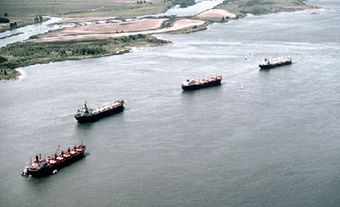Chaudière, Rivière
Rivière Chaudière, 193 km long and with a basin 6690 km2, is located in southern Québec. It is named after the waters that "boil" from its falls or after the numerous glacial erosion kettles (chaudière is French for boiler and also for bucket). The Abenaki called it Papawikotekw, meaning "river of tin bucket." It flows northeast from Lac Mégantic at the foot of the Montagnes Bleues (Blue Mountains), passes through the rapids of the Appalachian Plateau, and arrives at the St Lawrence Lowland downstream from Sainte-Marie, where it flows into the St Lawrence River almost opposite Québec City. It has a 35 m waterfall, "Le Saut de la Chaudière," 3 km from its mouth.
The winding river with its pebbly bed is known for its flooding and for the fertile land of its floodplain. This was an agricultural area until the beginning of the 20th century, but forest, wood, leather and textiles became the main industries towards 1950. Since that time the food, furniture, clothing, metals and printing industries have also flourished. As early as 1640, the Abenaki used the river to travel from the Québec City area to the coast of Maine. In late 1775, during the American Revolution, the troops of Colonel Benedict Arnold set out from Boston and used the route for their attack on Québec City. The main cities in the valley are Saint-Georges and Sainte-Marie.

 Share on Facebook
Share on Facebook Share on X
Share on X Share by Email
Share by Email Share on Google Classroom
Share on Google Classroom

